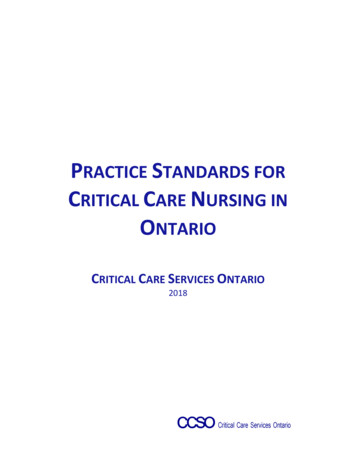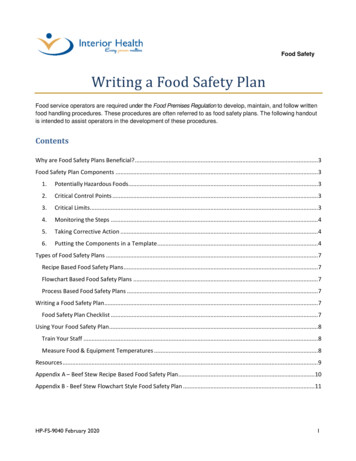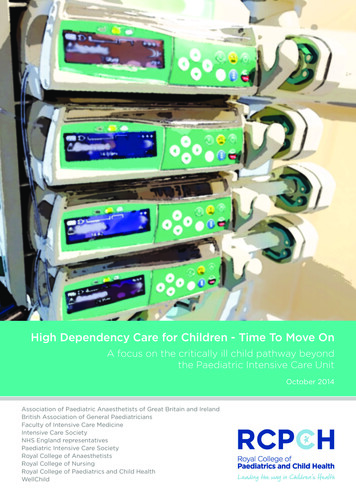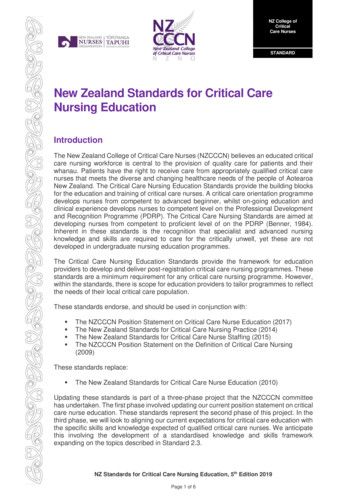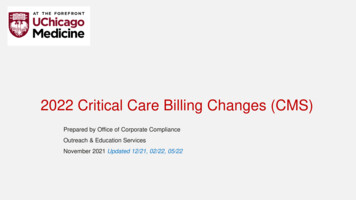
Transcription
How to Identify Critical Quality Attributesand Critical Process ParametersJennifer Maguire, Ph.D.Daniel Peng, Ph.D.Office of Process and Facility (OPF)OPQ/CDER/FDAFDA/PQRI 2nd ConferenceNorth Bethesda, MarylandOctober 6, 2015Opinions expressed in this presentation are those of the speakers anddo not necessarily reflect the views or policies of the FDA1
Outline Brief introduction on Quality by Design (QbD) Example approach to identify critical qualityattributes (CQA) Example approach to identify critical materialattributes (CMA) and critical processparameters (CPP) Illustrative examples Concluding remarks2
What is Quality by Design (QbD)? A systematic approach to development that begins withpredefined objectives and emphasizes product and processunderstanding and process control, based on sound science andquality risk management. (ICH Q8 R2)Predefined objectivesProduct and processunderstandingProcess controlSound science Systematic ApproachDefine Quality Target Product Profile (QTPP)Identify Critical Quality Attributes (CQA)Identify critical material attributes (CMA*) andcritical process parameters (CPP)Establish the functional relationships that linkCMA/CPP to CQADevelop appropriate Control Strategy, includingjustificationsScience-driven development (scientific literature,prior knowledge, DOEs etc.)Quality risk management Risk-based development (ICH Q9)* CMA definition will be given later.3
What is a Quality Target Product Profile(QTPP)?ICH Q8(R2) Definition: A prospectivesummary of the quality characteristics of adrug product that ideally will be achieved toensure the desired quality, taking intoaccount safety and efficacy.TPP: labeled use, safetyand efficacyQTPP: quality characteristicsto ensure safety and efficacy aspromised in the label4
Guidance for IndustryQ8, Q9, & Q10 Questions and AnswersThe Quality Target Product Profile (QTPP)provides an understanding of what willensure the quality, safety, and efficacy of aspecific product for the patient5
EXAMPLEQTPPQbD for ANDAs: An Example for IR Dosage Forms. April ANDAGenerics/UCM304305.pdf
Points to ConsiderGuide for ICH Q8/Q9/Q10 ImplementationThe Quality Target Product Profile (QTPP)describes the design criteria for the product,and should therefore form the basis fordevelopment of the CQAs, CPPs, andcontrol strategy.7
Definitions Critical Quality Attributes (CQA)– A physical, chemical, biological, or microbiologicalproperty or characteristic that should be within anappropriate limit, range, or distribution to ensurethe desired product quality (ICH Q8) Critical Process Parameter (CPP)– A process parameter whose variability has an impact on a CQA and thereforeshould be monitored or controlled to ensure the process produces the desiredquality. (ICH Q8) Critical Material Attribute (CMA)*– A physical, chemical, biological or microbiological property or characteristic ofan input material that should be within an appropriate limit, range, ordistribution to ensure the desired quality of output material.*CMA is not defined in ICH guidance, but used here for discussion purposes8
Approach to Identify CQAs1. Consider all DP quality attributes; physical attributes,identification, assay, content uniformity, dissolutionand drug release, degradation products, residualsolvents, moisture, microbial limits, etc.2. Identify a CQA based on the severity of harm to apatient (safety and efficacy) resulting from failure tomeet that quality attribute.– Identified before taking into account risk control– Does not change as a result of risk management9
EXAMPLEQTPP10
Not a CQACQAQbD for ANDAs: An Example for IR Dosage Forms. April 2012.11
Definitions Critical Quality Attributes (CQA)– A physical, chemical, biological, or microbiological property or characteristicthat should be within an appropriate limit, range, or distribution to ensure thedesired product quality (ICH Q8) Critical Process Parameter (CPP)– A process parameter whose variability has an impact on aCQA and therefore should be monitored or controlled toensure the process produces the desired quality. (ICH Q8) Critical Material Attribute (CMA)*– A physical, chemical, biological or microbiological propertyor characteristic of an input material that should be withinan appropriate limit, range, or distribution to ensure thedesired quality of output material.*CMA is not defined in ICH guidance, but used here for discussion purposes12
Relationship between CMAs, CPPs and ionCQAsOutputMaterials orProductCQAs f (CPP1, CPP2 , CPP3 CMA1, CMA2, CMA3 )13
Linking Patient - Product - ProcessPatientClinical Outcome(Safety & Efficacy)ProductCritical QualityAttributes(CQA)Formulation/ProcessCritical Material Attributes(CMA)Critical Process Parameters(CPP)14
Example Approach to Identify MaterialAttributes and Process ParametersUseful tools:Risk assessment, prior knowledge, established science .15
Example Approach to Identify MaterialAttributes and Process ParametersDrug Product CQAs:Content UniformityIntermediate CQAs:Blend UniformityProcess Variables:1. Particle size distribution2. Loading level3. Number of revolutions16
Identifying Potentially High Risk MAs or PPs Special considerations for unique DS/DP properties– e.g. RH can be potentially high risk for a hygroscopic formulationYu et al, Understanding Pharmaceutical Quality by Design, The AAPS Journal, 2014 , 16(4) 771- 78317
Example Approach to Determine CriticalityOnce potentially high risk variables are identified: Identify levels or ranges of these potentially high riskattributes and/or parameters. Design and conduct experiments, using DOE whenappropriate. Analyze the experimental data to determine if amaterial attribute or process parameter is critical.– If variability has an impact, then need to monitor and/or control Develop a control strategy.18
Key Points from EMA-FDA QbD Pilot Pilot program aimed at a parallel assessment of CMC sectionswhich are relevant to QbD The fact that a risk of failure is mitigated by applying a robustproactive control strategy should not allow for theunderestimation of assigning criticality. Agencies are amenable to the applicant using their ownterminology in the pharmaceutical development section tocommunicate development findings However, in the 3.2.P.3.3 “Description of the ManufacturingProcess and Process Controls” and 3.2.P.3.4 “Control ofCritical Steps and Intermediates” sections, the description ofall parameters that have an impact on a CQA should be19classified as critical.
Increased ControlIncreased RiskCriticality1. Continuum2. Focus on the vital few3. The control strategy (theestablished range) isimportant4. If underlying assumptionschange, then criticality canchangeWhat's in a name? That which we call arose by any other name would smell assweet. – William Shakespeare20
Schematic Flow Diagram for Identification ofCMAs/CPPsCan the CQA beimpacted byformulation andprocess variables?YesNo or low potentialIs variableshown to beor likely to bepracticallysignificant?NoDoes studiedrange captureintendedvariability?Yes*NoYes* Changes to the range may impact criticality and need to be re-assessed!21
Illustrative Examples22
Example-1 A fixed-dose combination IR tablet:– API-1: 80% of the tablet weight– API-2: 1% of the tablet weight– Diluent (microcrystalline cellulose): 14% of thetablet weight– Other excipients: disintegrant, colorant, andlubricant– Content Uniformity (CU) of API-2 is a high risk CQA23
24Process Flow Diagram
Process Understanding and Control Process understanding:– Ranked all blending steps as medium risk; hence, nodevelopment study was conducted– Provided testing results of one lab scale batch (4-quart Vblender, 1.2 kg) and exhibit batch (20 cu. ft. 184 kg) Applicant’s control strategy: fix all MAs and PPs for allblending steps Agency’s comment: All MAs and PPs are potentiallycritical due to limited characterization of the sourcesof variability and inadequate understanding of theimpact of CMAs and CPPs on the drug product CQAsKnowledge is power ! - Francis Bacon25
Example -2 An Extended–Release (ER) Capsule API: 100 mg– highly soluble, excellent chemicalstability, no polymorphism Manufacturing Process:– Seal-coated sugar sphere core– API coated pellets– ER polymer coated pellets– Encapsulation and packing Dissolution is a high risk CQASeal coatSugarCoreSphereAPI coatER coat26
ER Polymer Layer Formulation ER polymer layer:– Polymer-1 (release controlling, water insoluble)– Polymer-2 (pore former, water soluble)– Plasticizer B– Colorant Formulation feasibility studies– Trial with IR pellets ER pellets (abandoned)– Effect of Polymer 1 viscosity– Effect of Polymer 2 type– Effect of plasticizer type: Plasticizer A vs. B(hydrophobic vs. hydrophilic)27
Formulation Optimization One-factor-at-a-time (OFAT) approach– Polymer-2 quantity– Polymer-2 viscosity– ER layer coating weight gain Applicant’s conclusion: No impact ondissolution; hence, these factors are not critical Agency’s comments: Any interaction? How’sthe range justified? Coating process variability?28
Further StudiesB: ViscosityDisso @ 4h ER layer coating weight gain andPolymer-2 viscosity have stronginteraction. Both factors are critical! Control strategy:– Using fixed amount of Polymer1 and Polymer-2– Tighten the Polymer-2 viscosityto the studied ranges instead ofcompendial limitsA: ER layer coating weight gainDon’t use insufficiently powered studies to force a favorable conclusion ofnon-criticality. The narrow range of ‘non-critical process parameter’ is stillpotentially critical.29
Example-3 Oral IR tablet: EQ 5mg base API loading: 4% Diluents: microcrystalline cellulose ( 60%) andlactose monohydrate ( 30%) Other excipients: disintegrant and lubricant Manufacturing Process:– blending, milling, blend lubrication– roller compaction and milling, blend lubrication– compression and aqueous based film coating Content Uniformity is a high risk CQA30
Summary of MAs and PPs Evaluated31
Process Development32
So What is Critical? The applicant’s conclusion:– No critical process parameters, intermediates orprocess steps have been identified within theranges studied during development. The Agency did not focus so much on theterminology, but Paid a lot of attention to the studied ranges andverified if these ranges are captured in thecontrol strategy, process description, and33master batch record .
Control Strategy* Changes to the range may impact criticality and need to be re-assessed!34
Example-4 Oral IR tablet: 2.5 mg and 5 mg Drug substance: BCS high solubility, non-hygroscopic, onlyone crystalline form known, excellent chemical stability API loading: 2.4% Diluents: microcrystalline cellulose ( 40%) and lactosemonohydrate ( 50%) Other excipients: disintegrant, wetting agent, and lubricant Manufacturing Process:– blending, screening, lubrication, roller compaction, milling,blending and lubrication, compression, and film-coating Content Uniformity is a high risk CQA35
Process Understanding and Control Strategy In-line NIR method todetermine BU and blendingendpoint At-line NIR method for tabletAssay and CU (Large N) Other traditional in-processcontrols: ribbon density,ribbon thickness, core tabletweight & hardness36
So What is Critical? Flexible for input material attributes and processparameters Agency looked carefully at the NIR method,model development, validation, lifecyclemaintenance plan The established NIR method, instrument details,spectral acquisition and sampling, spectral dataprocessing, calculation/reporting and theacceptance criteria are included in P.3.4 “Controlsof Critical Steps and Intermediates”.37
Impact on Post-Approval Changes Level 1: flexible input materialattributes and process parameters;real-time automatic controls assurethat CQAs consistently conform tothe established acceptance criteria Level 2: flexible material attributesand process parameters within theestablished design space Level 3: any significant change inthese MAs and PPs warrantsregulatory oversightControl Strategy Implementation OptionsYu, et al. Understanding Pharmaceutical Quality by Design, The AAPS Journal, 2014, 16(4): 771-78338
Concluding Remarks Systematic approach, begin with the end in mind Identify CQAs based on patient's needs: safety andefficacy Use science- and risk-based approach to identifymaterial attributes and/or process parameters thatmay impact CQAs Prioritize development studies and focus on the vitalfew potentially high risk material attributes andprocess parameters Establish an appropriate control strategy Consider discussing lifecycle management plans39
Acknowledgements Christine Moore Robert Iser Rapti Madurawe Naiqi Ya Ubrani Venkataram40
October 6, 2015 . Opinions expressed in this presentation are those of the speakers and do not necessarily reflect the views or policies of the FDA . Outline Brief introduction on Quality by Design (QbD) Example approach to identify critical quality attributes (CQA)

